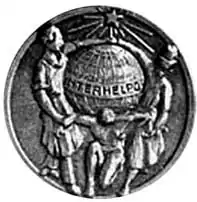
Interhelpo (international laboristal helpo) was an industrial cooperative of workers and farmers (Esperantists and Idists) between 1923 and 1943, established for the special purpose of helping to build up socialism in Soviet Kyrgyzstan. The legal framework for the migration of working forces from the West to the Soviet Union was established through a resolution on “Proletarian help for Soviet Russia” (proletarskaya pomoshch’ sovetskoy Rossii) adopted by the Fourth World Congress of the Communist International (1922).[1]
On May 1, 1923, Interhelpo — an acronym of the Ido compound international laboristal helpo — was founded in Žilina, Czechoslovakia (now Slovakia) on the initiative of the Czechoslovak Bolshevik Rudolf Pavlovič Mareček, who had actively participated in fights against Basmachis in Semirechye and was editor of the newspaper Zarya Svobody ("The Dawn of Freedom") in neighboring Verniy.[2][3] Other Czechoslovak agricultural cooperatives founded with the aim of building socialism in the USSR were the Kladno Commune (Armavir, Krasnodar Krai), the Slovak Commune (Stalingrad Guberniya), Reflector (Ershovsk, Saratov Oblast), Pflug (“plow”), Solidarita, and Čechocentr.[4]
From 1925 onwards, trains from the railway station in Žilina transported 1078 people (including mainly Czechs and Slovaks, but also Hungarians, Ruthenians and other nationalities, and including both direct members and their families) to Kyrgyzstan.[5]
Activities in Kyrgyzstan
Its members made many products on the ‘green meadow’. The famous Slovak politician Alexander Dubček also participated in this cooperative in his youth.
The cooperative's most notable projects include:
- in 1925: an electric power station
- in 1927: a textile factory
- in 1928: a melting-house
- a furniture factory
- railroads, hospitals, main government building in the capital of Kyrgyzstan
- a club house and cultural venue (klub pařížských komundartů)[6]
In 1925, the Interhelpo was declared the best cooperative in the Soviet Union. At one point, it produced 20 percent of Kyrgyzstan's industrial products.[7]
In 1927, members of the cooperative formed a theatre group, which performed plays under the supervision of the theatre director Eduard Peringer in the carpenter’s workshop in Czech, Slovak, Hungarian and other languages.[8]
In 1930, the Czechoslovak journalist Julius Fučík visited the cooperative.[9]
By 1932, the cooperative comprised members of different backgrounds of whom many were recruited from within Soviet Kyrgyzstan: 223 Russians, 92 Czechs, 66 Ukrainians, 43 Slovaks, 37 Kyrgyz, 26 Germans, 22 Hungarians, 3 Uyghurs (Kasghar), 2 Uzbeks, 2 Mordovians, 2 Tatars, 1 Jew, 1 Armenian, and 1 Rusyn.[10]
In 1943, during the Second World War, the property of the Interhelpo cooperative was transferred into the hands of the state.
Legacy
Today the cooperative's residential buildings on Intergel'po Street (former site of the cooperative) are in a desolate state and are inhabited mostly by marginalized segments of society (such as e.g. internal working migrants from Southern Kyrgyzstan):
"In the accounts of most residents, the builders of the districts where either unknown, or misrepresented as “Czech prisoners of war” or “Czech war refugees,” who had ended up in Central Asia in the aftermath of World War II. Today, almost a hundred years later, little reminds today’s residents of the achievements of the cooperative. Only Nazdar, a small Czechoslovak association, tries to preserve its historical heritage with financially limited funds."[11]
In 2008, Czech National Television released the documentary Interhelpo. Historie jedné iluze (“Interhelpo – The History of an Illusion”) which portrays the historical experience of the cooperative largely in negative terms, highlighting human losses and the ultimate failure of the cooperative.[12]
See also
External links
- Site dedicated to Interhelpo (in Russian)
- Multimedia tour through the history of Interhelpo (2019)/
- STORIA: Interhelpo, la cooperativa esperantista cecoslovacca nel Kirghizistan sovietico (Interhelpo, the Czechoslovakian Esperanto cooperative in Soviet Kyrgyzstan) Article by Martina Napolitano (in Italian).
- The ruins of socialism in Bishkek: industrial cooperative Interhelpo by Nelly Dzhamanbaeva, Nov 19, 2019.
- Interhelpo and the making of industrial Bishkek – walking tour a blog article (rich of photos) by Lisa Germany, July 6, 2019.
References
- ↑ Leupold, David (2021). "'Building the Internationalist City from Below': The Role of the Czechoslovak Industrial Cooperative "Interhelpo" in Forging Urbanity in early-Soviet Bishkek". International Labor and Working-Class History. 100: 27. doi:10.1017/S0147547920000228. ISSN 0147-5479. S2CID 229513972.
- ↑ Kanimetova, A. M., ed. (1982). U istokov druzhby. Istoriya promyslovogo kooperativa Intergelpo. Sbornik dokumentov i materialov. Frunze. p. 7.
{{cite book}}: CS1 maint: location missing publisher (link) - ↑ Kokaisl, Petr (2012). Dějiny Kyrgyzstánu očima pamětníků : 1917-1938. Amirbek Usmanov, Za hranice Společnost pro rozvojovou spolupráci při Provozně ekonomické fakultě ČZU v Praze. Praha: Nostalgie. p. 166. ISBN 978-80-905365-0-0. OCLC 829661782.
- ↑ Schneider, Miroslav (2007). Die tschechoslowakische Auswanderung in die Sowjetunion in der Zwischenkriegszeit (1921-1939). Dissertation defended at Universität Regensburg. pp. 81–114.
- ↑ Leupold, David (2021). "'Building the Internationalist City from Below': The Role of the Czechoslovak Industrial Cooperative "Interhelpo" in Forging Urbanity in early-Soviet Bishkek". International Labor and Working-Class History. 100: 32. doi:10.1017/S0147547920000228. ISSN 0147-5479. S2CID 229513972.
- ↑ Pollák, Pavel (1961). Internacionálna pomoc československého proletariátu národom SSSR : dejiny česko-XIII. 5. slovenského robotníckeho družstva Interhelpo v sovietskej Kirgízii. Bratislava: Slovenská Akadémia Vied. p. 185.
- ↑ Canby, Peter (26 August 2018). "The Day the Soviets Arrived to Crush the Prague Spring, in Rarely Seen Photos". ISSN 0028-792X. Retrieved 24 September 2019.
- ↑ Samuel, I.I. (1935). Chekhoslovatskiy Promyslovy Kooperativ v Kirgizii. Leningrad. p. 68.
{{cite book}}: CS1 maint: location missing publisher (link) - ↑ Leupold, David (2021). "'Building the Internationalist City from Below': The Role of the Czechoslovak Industrial Cooperative "Interhelpo" in Forging Urbanity in early-Soviet Bishkek". International Labor and Working-Class History. 100: 42. doi:10.1017/S0147547920000228. ISSN 0147-5479. S2CID 229513972.
- ↑ Pollák, Pavel (1961). Internacionálná pomoc československého proletariátu národom SSSR : dejiny československého robotníckeho družstva Interhelpo v sovietskej Kirgízii. Bratislava: Slovenská Akadémia Vied. p. 206.
- ↑ Leupold, David (2021). "'Building the Internationalist City from Below': The Role of the Czechoslovak Industrial Cooperative "Interhelpo" in Forging Urbanity in early-Soviet Bishkek". International Labor and Working-Class History. 100: 49. doi:10.1017/S0147547920000228. ISSN 0147-5479. S2CID 229513972.
- ↑ Jaromir Marek, “Interhelpo. Historie jedné iluze”, documentary film, https://www.ceskatelevize.cz/ivysilani/10123387223-interhelpo-historie-jedne-iluze/30729535042